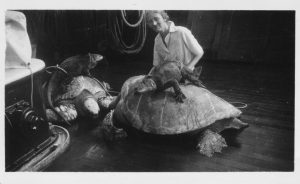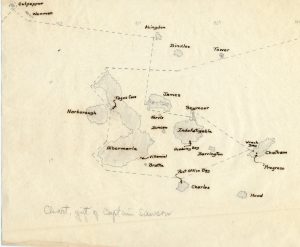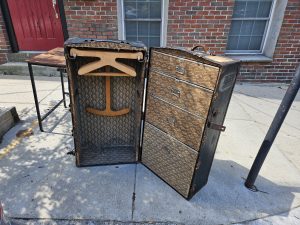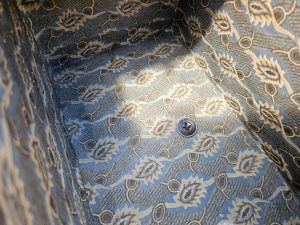It was there on Sumner Street, just a couple short blocks from my home. A fine old steamer trunk that may have been new around 1930. I hadn’t noticed it when I headed out. Who knows in which house it had been stored, in which deep closet or dusty attic.
My Godmother Helen
Helen, my godmother, my father’s aunt, had had such a steamer trunk. I remember emptying it of various small items when Ruth, her sister-in-law, and I sorted out the apartment when Helen transitioned into nursing care.
Helen was born July 13, 1892, in Hatfield, Massachusetts. She was educated at Mt. Holyoke College (BA in French. 1914) and Teachers College of Columbia University (graduate work, 1932). She was an itsy little thing, fragile of bone, with fine, pale-parchment skin, sky-blue eyes, and glorious strawberry-blonde hair. She never married. Most summers, until she was in her eighties, she frolicked at Shepherd’s Nine, a eurythmics camp in Connecticut where participants wore floaty, Greek-style garments and slept in tents.
From the Pacific to the South Seas
Helen was a traveler, an independent and eminently respectable Edwardian lady. She taught, she did translations, she worked as a companion-secretary. She spent most winters when I was young in Puerto Rico giving English lessons. For a long time, “home” was a room at the YWCA on Clarendon Street in Boston. She went often to Madrid, Spain, where she worshipped in the Prado museum at the altar of Diego Velazquez. She consulted the oracle at Delphi in Greece more than once.
For me, her legendary excursion took place in 1934 aboard the Hussar V, the yacht belonging to E.F. Hutton and Marjorie Merriweather Post. Ostensibly Helen was hired as tutor to ten-year-old Nedenia Hutton, she who later became the actress Dina Merrill (1923-2017). (The ship is now called the Sea Cloud and Dan and I sailed on her in 2014. There are five posts on the experience.)
Helen embarked with the family, a couple friends, and an enormous staff and crew in Miami, Florida. They sailed the Caribbean and through the Panama Canal, open only since 1914. First stop? The Galápagos Islands of Ecuador. They spent February there and in March turned toward the Marquesas and Tahiti. Their trip ended in the American territory of Hawaii. Helen disembarked there, took a commercial ship to Los Angeles, and traveled by train back to the East Coast.
One Requires Luggage
Almost three months at sea requires a capacious suitcase, at the very least. While Helen’s frocks were probably a modern size 0, and she didn’t need much in the way of woolens, coats, or exotic footwear, she did require a wardrobe. Dinner was generally a dressier affair, served by butlers and maids. After all, we are talking E.F. Hutton and Marjorie Merriweather Post, here.
A steamer trunk is essentially a portable closet. It generally has hangers, drawers, and space for shoes, as well as objects like books, writing materials, a sewing kit, or a camera. A large, expensive trunk might have several other features. I would guess that Helen owned a steamer trunk by 1922, when I have a record of her traveling to England. She headed off to France in 1932. There may well have been other journeys.
When her main mode of transportation changed from steamship to airplane, I am sure her luggage became more portable. Schlepping a steamer trunk around from hotel to hotel every few days when you are a little over five feet tall and less than one hundred pounds isn’t really manageable.
Abandoned on the Street
When I saw a beautiful steamer trunk propped open on the Sumner Street curb, I stopped.
It bore the Tuerke label, a company that opened in Baltimore, Maryland, in 1899. Once the premier purveyor of fine luggage and such in the area, it filed for bankruptcy in 1993. The initials A.S.C. above the legend Balto. Md. caught me by surprise. Someone about one hundred years ago may have made the same trek to Sumner Street in East Boston, from Maryland, that I had just made myself.
It’s a beautiful trunk. It had been shipped by REA, Railway Express Agency, the Fed Ex of its day. Founded in 1918, the company folded in 1975. Lutherville got its first railway station in 1853, so that may well have been REA headquarters in the Baltimore area.
The interior is lined with a blue, beige, and brown, paisley-esque, abstract floral fabric that is still in excellent condition. Someone’s missing button languished in the top drawer. All the wooden hangers appear to be intact. It appears to have been well traveled. Past labels left ghostly outlines on several surfaces.
Just lovely.
Time Travel
Sumner Street would have looked fairly similar to how it does now in 1920 or 1930, even 1960. Except, of course, for the cars parked there. It’s a red-brick street. Our Lady of the Assumption, a Gothic Revival beauty on the north was completed in 1874. Some of the buildings probably date to the late 18th century. Most of Eastie was settled in the 1830s when wooden boat-builders had all the business they could manage, and goods and immigrants were shipped in and out of port. The homes are a hodge-podge of styles and dates, either brick or balloon frame.
I have left heaps of packing boxes out on garbage day for the last four or five weeks. That beautiful steamer trunk abandoned on the sidewalk is a melancholic sight and—yet—a comforting reminder that many have made this neighborhood home, whether or not they came from Baltimore.






